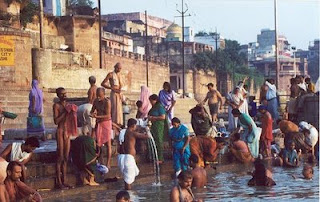Three people died in the city of Bhopal, in north-central India, in a battle between neighbors for scarce water,
The Guardian reported this past week.
 Fights regularly broke out when the water tankers that serve 100,000 of the city’s residents make their deliveries.
Fights regularly broke out when the water tankers that serve 100,000 of the city’s residents make their deliveries.
The monsoon this year produced less rain than usual, exacerbating a drought. In addition, the number of people in Bhopal’s slums is growing. “The population has increased, but the water supply is the same,” a local committee chairman told The Guardian.
The northern parts of India were hardest hit, but much of India experienced similar conditions, including the city of Mumbai. Officials there cut water supplies for the city by 30 percent when the levels of the five lakes that serve as Mumbai’s primary sources of water dropped dangerously low.
But while heavy rains in the last few days mostly restored supplies, they also shut down the waterlogged city, reviving fears of 2005’s deadly floods. According to a new book and exhibit by University of Pennsylvania architects, the sprawling city has paved over the mangrove wetlands that protect it from flooding.
Pollution, climate change, population growth, urbanization, and industrialization in the world’s developing countries continue to increase demand for its finite water supplies. Today, 700 million people live in countries experiencing water scarcity or stress; by 2035, that figure is expected to have reached 3 billion people, or almost half of the world’s population. Asia, with 60% of the world’s population but only 36% of the world’s freshwater, will be particularly hard hit.
The problems vary across South Asia. The rivers around Dhaka, Bangladesh, are so polluted from industrial dumping that specialists are saying the situation is beyond repair. Lack of access to clean water and knowledge about hygienic sanitation practices leads to thousands of preventable deaths from diarrhea every year in Nepal. In Karachi, Pakistan, stealing public water out of pipes and tankers is a $500 million industry, “a mark of the state’s decreasing capacity to provide for its own,” reports Bill Wheeler in a special report in GOOD magazine.
The Indus Waters Treaty of 1960 between India and Pakistan has long been hailed as an example of the cooperation that can result from the necessity of sharing such an essential resource across borders. But with climate change causing the Himalayan glaciers that feed the Indus River to melt at a faster pace, some experts warn that balancing the water needs of both countries across their contested border could be a trigger point for conflict—particularly for two nations that cannot provide many of their citizens with access to safe drinking water under normal circumstances.
South Asian governments will be called upon more and more to balance the water of needs between different users at the local level and work with other governments to share and conserve water at the international level. But as Ashok Jaitly of New Delhi’s Energy and Resources Institute told Wheeler, both India and Pakistan share a “mentality that obscures the need to manage demand with conservation, water tariffs, and an end to destructive but politically popular practices in both countries.”
Despite the recognition of water as a growing security issue by the international community, it is difficult to improve what is a symptom of deeper-set problems. But they must try, if only for their own security. As Pakistan President Asif Ali Zardari warned in a Washington Post op-ed, “The water crisis in Pakistan is directly linked to relations with India. Resolution could prevent an environmental catastrophe in South Asia, but failure to do so could fuel the fires of discontent that lead to extremism and terrorism.”
By Comparative Urban Studies Project intern Elizabeth Hipple and edited by Meaghan Parker
Photo: The Ganges River in Varanasi, India. Courtesy flickr user Denver Pam Fights regularly broke out when the water tankers that serve 100,000 of the city’s residents make their deliveries.
Fights regularly broke out when the water tankers that serve 100,000 of the city’s residents make their deliveries. A Publication of the Stimson Center.
A Publication of the Stimson Center.

 Fights regularly broke out when the water tankers that serve 100,000 of the city’s residents make their deliveries.
Fights regularly broke out when the water tankers that serve 100,000 of the city’s residents make their deliveries.

